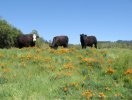If you buy beef at your local supermarket, chances are it comes from cows that were fed corn. Though cows are ruminants by nature, designed to digest grass, the cattle industry has been using corn for decades to fatten up cattle. A grain-based diet, however, causes many health problems for cattle — and unhealthy cows mean unhealthy meat. Not only does meat from corn-fed cows carry the risk of pathogens such as E. coli, it is nutritionally inferior to meat from grass-fed cows.
The evolution of a corn-fed cattle industry
Several decades ago, the cattle industry began feeding cattle a diet based on grain, particularly corn. During World War II, farmers were producing more grain than the American population could consume, so they started feeding the surplus to cattle. They found that a grain-fed diet allowed them to fatten up cows faster for slaughter. Seventy-five years ago, it took a cow 4 or 5 years to reach a weight of 1,200 pounds. Today, says John Robbins, author of author of The Food Revolution: How Your Diet Can Help Save Your Life and Our World, cattle can be slaughtered at just 14-16 months of age, thanks to massive amounts of corn, protein supplements, antibiotics, and growth hormones,
Unhealthy cows mean unhealthy meat
Switching cows from grass to grain puts more money in the beef industry’s pockets and cheaper meat on the supermarket shelves. But at what price? The stomachs of cows are naturally pH neutral. A corn-based diet, however, creates an acidic environment that contributes to a host of health problems. Corn-fed cattle are prone to serious health conditions such as bloat, diarrhea, ulcers, liver disease, and a weakened immune system. To combat these health problems, cattle are continually fed antibiotics, which leads to the development of antibiotic-resistant bacteria that increasingly render modern medicine ineffective.
The threat of E. coli
An acidic intestinal tract also favors the growth of E. coli. Michael Pollan, author of The Omnivore’s Dilemma, states that the lethal strain of E. coli known as 0157:H7 is believed to have evolved in the gut of feedlot cattle. The development of a more acidic environment in cows’ intestinal tracts created an acid-resistant strain of the pathogen, which is able to survive the acidic conditions of the human stomach and prove fatal. In the documentary Food, Inc., Pollan states that switching feedlot cattle to a grass diet would eliminate 80 percent of the E. coli in the cows’ digestive tracts.
The benefits of grass-fed beef
Aside from posing the danger of E. coli, corn-fed beef contains far fewer nutrients than grass-fed beef. Prevention reports that a recent study by the USDA and researchers from Clemson University found grass-fed beef to be significantly higher in calcium, magnesium, beta-carotene, and potassium than corn-fed beef. In addition:
Meat from grass-fed cattle is lower in both overall fat and artery-clogging saturated fat.
Grass-fed meat is higher in healthy omega-3 fats. Meat from feedlot animals has been found to contain only 15-50 percent as much omega-3s as meat from grass-fed cattle.
Meat from grass-fed livestock is four times higher in vitamin E.
Grass-fed meat is higher in conjugated linoleic acid (CLA), a nutrient associated with lower cancer risk.
What you can do
Look for grass-fed beef at specialty stores, farmers markets, and health-food chains such as Whole Foods. Grass-fed beef is labeled and is usually more expensive than industry-standard corn-fed beef. To save money, buy cuts on the bone; processors usually charge extra for deboning.
Remember that grass-fed and organic are not the same thing. Natural food stores often sell organic beef and dairy products from animals raised without antibiotics or hormones. While these animals were likely fed less grain than the industry norm, they may still come from feedlots where they were fed grain. Look for meat labeled both grass-fed and organic.
Consider buying beef directly from a local farmer, which can be as cheap as $5 per pound. Many farmers will allow customers to visit the farm to ensure that cattle are being raised in healthy conditions. To find a farm in your area, visit www.eatwild.com.



